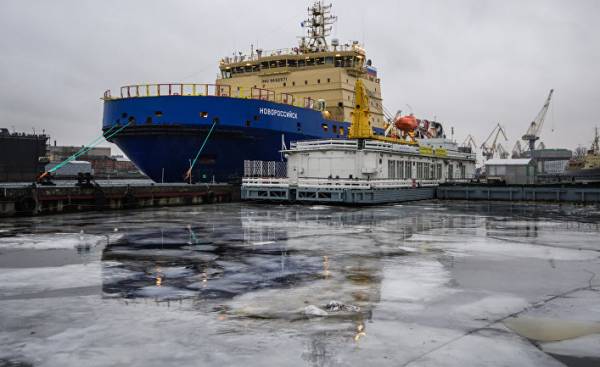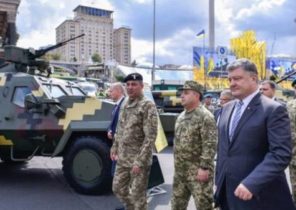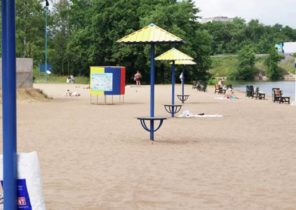
The ice rumbles and shakes from the action of 25 thousand horsepower.
Fifty kilometers North of Arkhangelsk newest Russian icebreaker “Novorossiysk” moves along the Dvina river in our direction — to the Arctic.
The inhabitants of the island at sawmill No. 14 and employees of Aftenposten stand on the ice and watch as the giant height of nine floors slowly passes at a distance of 4-5 feet from them, crushing the ice into small pieces.
A crushed mass of ice bubbling in the back of the ice breaker and leaves in the ice two feet thick open lane width of 12 meters.
“Hurrah! Long live Russia!” — shouted Sergey, light Keeper buoy No. 3.
“Hold, friends! I will forward you soon”.
The new icebreaker Russia
One of the biggest and strong changes of the oceans occurs in the Arctic.
Sea freight by the shortest route from Europe to China last year increased by 35% to 7 million tons. Court transport oil, liquefied gas, coal, ore and other dry cargo.
“In 2022 we will carry 40 million tons. Ten times more than in 2014,” said this week in Arkhangelsk Deputy Prime Minister Dmitry Rogozin.
Russia is a leading player in the Arctic, with 30 diesel and four nuclear-powered icebreakers.
Before Christmas, construction began on the first Chinese nuclear-powered icebreaker — as large as “Novorossiysk”. According to the plan, it needs to become operational in 2019.
Big dreams in the eternal darkness of the Arctic
The first flight in the Arctic is always the hardest.
The captain of the “Novorossiysk” Yaroslav Werbicki and a team of 35 people has just returned from a flight to the Franz Josef Land, and again they have to go to the Arctic voyage after three days of Parking in Arkhangelsk.
Captain happy.
“We can go in the ice thickness of 1.5 meters”, — proudly declares Jaroslav Werbicki.
The vessel has four diesel generator with a capacity of 4.5 million kilowatts, can move at 120 meters mass of ice in 10 thousand tons.
The reserve is 20 thousand kilometers. The ship is not accidentally named in honor of the New Russia. Novorossiysk is the name of the main Russian port on the Black sea which the Russians had conquered from the Turks in 1829.
The Arctic makes great savings of time
Warming our planet and melting of ice are an important reason that Russia sees the possibility of obtaining higher income from transporting goods in the Arctic.
Transportation is the most profitable part of the oil and gas industry, but the competition is very high.
According to the head of the scientific-expert Council of the State Commission on development of the Arctic, Yuri Sychev, on the way from Europe to Southeast Asia can save you approximately 10 days.
The Russian also have the opportunity to save on transshipment of containers with the Asian goods to ice class vessels in Petropavlovsk Kamchatsky.
The possibility of salvation for the future of Russia
The captain earns in a month in terms of Norwegian kroner of approximately 22 thousand (approximately 145 thousand rubles — approx. TRANS.) for command of an icebreaker and a team of 35 people.
Many of the team start its first Arctic voyage.
“Without our ice-breakers it would be impossible to use the port and sea route from Murmansk to the Pacific ocean. It is very important for Russia,” says Werbicki.
— How is life on Board the icebreaker when you are a few months in the Arctic?
“First of all it’s darkness. And a lot of hard work.”
The new route from Europe to Asia
The Northern sea route will replace the Suez canal, but the consequences, nevertheless, are great.
The Deputy Prime Minister of Russia believes that the shortest way to China in a few years, can replace 20% of the total Maritime traffic in Asia, which is currently being implemented through the Suez canal.
Thus, huge volumes of oil, gas and coal will go from the Norwegian coast in the West to the Bering Strait in the East.
Giant constructions in the Arctic
The main reason for the increase of shipping, in addition to abrupt climate change, is the implementation of major gas projects in the Russian Arctic.
Within two years 16 million liquefied natural gas must be transported by tanker from the new LNG terminal in Yamal Peninsula.
It is on mine, Russia decided to make a huge bet — and bringing it with shtokmanskoe field in the Barents sea, where Norwegian politicians and leaders of the oil industry dreamed about Norwegian-Russian energy tale.
In Yamal, the Chairman of the Board of “NOVATEK”, and the third richest Russian oligarch with assets of $ 155 billion CZK (about 1 012,15 billion RUB) have built the world’s largest land gas field.
“We thought at first that the port will be open only for 4-5 months in a year. But now we see that ships go 7-9 months in a year”, — said the head of “NOVATEK” Leonid Mikhelson at the Arctic forum in Arkhangelsk.
What will become of the Arctic resources?
The price for billions of dollars in investments to pay, in particular, the inhabitants of the island at sawmill No. 14, who watched the icebreaker was lost in the Arctic haze.
At some point all felt that they are part of something big that causes pride.
And now the work begins, and you need to try an adventure to get home.
“We live in one of the most resource-rich regions of Russia with enormous natural wealth. But look at how we live,” says Maria, waiting for when he will throw bridges across the ice.
Tap water on the island so contaminated that the residents themselves have to carry water.
“My two year old daughter should now be vaccinated, but we were told that schools and hospitals have no money”, — says Alexei.
He, the chauffeur, has three children, they live in a dilapidated shack built in the fifties, and pay 1.1 thousand CZK (approximately 7 180 rubles — approx. TRANS.) for electricity and in the form of various fees.
His wife works in the hospital for 2.2 thousand kronor (about 14.4 thousand rubles — approx. TRANS.) in a month. All employees have cut wages by 30%.
A new school was supposed to be finished back in the nineties, but the site is still undeveloped.
“The only thing that is built here is the new shopping malls, luxury apartments and beautiful offices for our corrupt local politicians and oligarchs”, — says Alexei.
A tough battle behind the scenes in the Kremlin
Low oil prices, the economic crisis and Western sanctions have taken a heavy toll on the Arctic ambitions.
A large Russian icebreaker fleet in the literal sense will soon be eaten by rust.
By 2020, three of the four Russian icebreaker will be so worn out that they will need to be replaced, according to Russian scientists.
Many of the older diesel-powered icebreakers have been decommissioned.
“There is no money to build a new fleet, the country has no “long” and “cheap” money. Therefore, the fleet is aging,” warned Mikhail Grigoriev of Academy of Sciences of Russia in an interview with TASS.
“Russia really lacks a strong technical vessels”, — said Deputy Prime Minister Dmitry Rogozin.
He is trying to get billions more for the next generation of nuclear-powered icebreakers of the class “Leader” for 1.2 billion dollars for the ship.
So bears live in the North
Sergey is working in shifts (shift lasts 24 hours) and gets 15 crowns (about 98 rubles — approx. lane) per hour for work on the ice, providing people safe passage.
However, he was not discouraged, and full of plans.
“Please! Now we can go!” — shouted Sergey. The islanders quickly moving along with baby carriages, food and water.
He and his wife are saving money to buy a house in the Crimea.
“There we will live better, though the fishing would be worse. When the Ukrainians deal with the oligarchs who profit from war, Poroshenko, there will be peace”, — said Sergey.
Then he goes to the van to relax a bit.
Four hours will suit a new boat, then you need to clean up, and then laid again.
“That’s how we live. We polar bears”, — says Sergey.







